The Ultimate Free Walking Tour of Munich (For 2025)
This article may contain affiliate links, meaning I may earn a small commission if you purchase through these links at no extra cost to you. Please refer to my Disclosure Policy for more information.
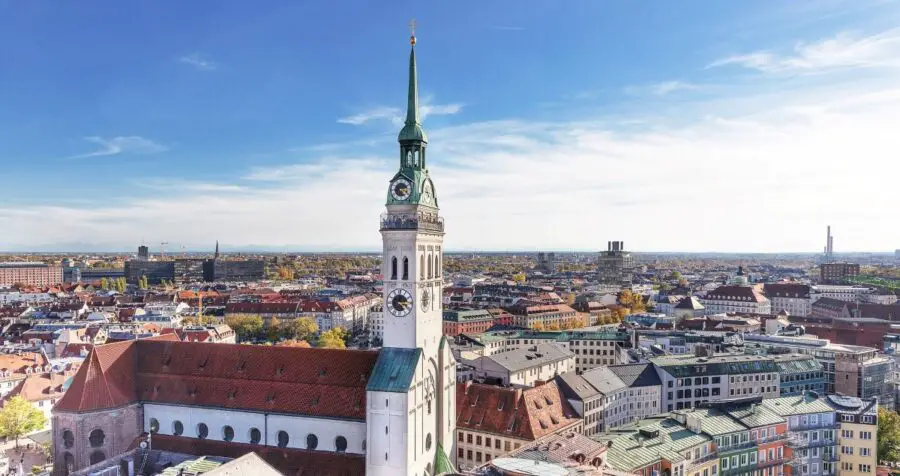
Ah… Munich. A city known for Oktoberfest, Munich offers more than just beer. Filled with museums and historical sites and surrounded by extravagant castles, Munich is one of the best cities in Germany. And there’s no better way to explore this delightful Bavarian city than on a free walking tour of Munich!
This self-guided Munich walking tour is not just doable — it’s called for. Where else can you find over a dozen historical monuments, breathtaking city views, and lively plazas packed into less than one kilometer?
And while some walking tours of Munich may be tiring, this one has a total walking distance of only 35 minutes. This means you’ll have plenty of time to take it easy, wander around, and dive into the legends of these unique Munich landmarks.
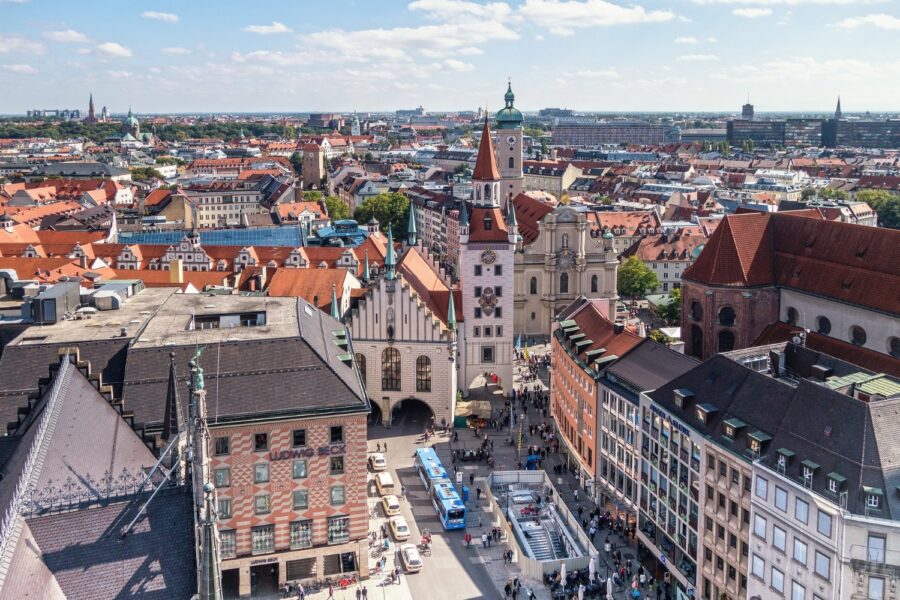
However, you should still set aside at least 1 day in Munich to do this tour, as there’s plenty to do at each stop.
Well, without further ado, let’s begin!
A Quick Summary of Your Free Walking Tour of Munich
- Karlsplatz-Stachus
- Bürgersaalkirche (Citizen’s Hall Church)
- Michaelskirche (St. Michael’s Church)
- Frauenkirche (Church of Our Lady)
- Marienplatz
- Neues Rathaus (New Town Hall)
- Altes Rathaus (Old Town Hall)
- Peterskirche (St. Peter’s Church)
- Asamkirche (Asam Church)
- Viktualienmarkt (Victuals Market)
- Hofbräuhaus München
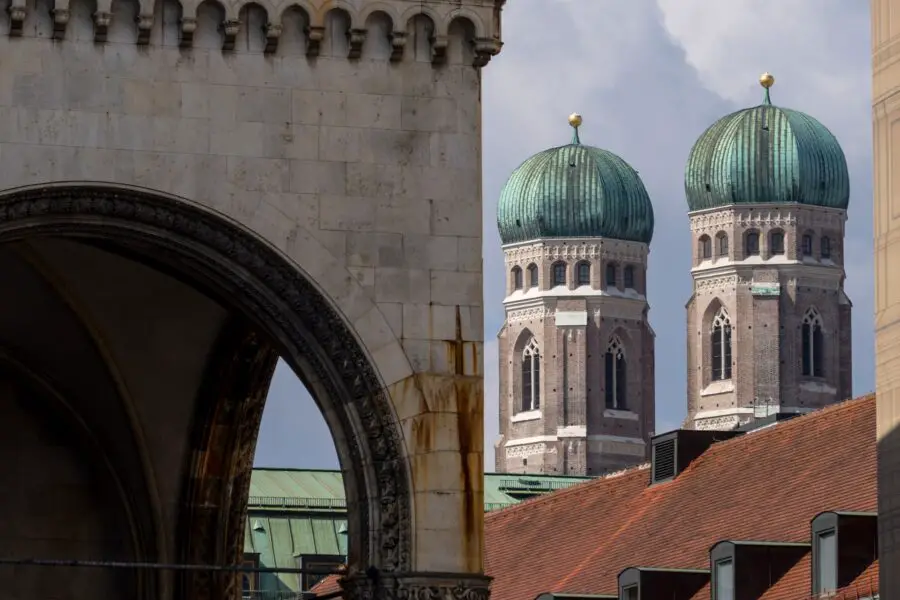
Needless to say, this free walking tour of Munich will take you to all the top spots. So get your camera ready, put on some comfortable shoes, and prepare to spend one perfect day in Munich (one of the best places to visit in Bavaria!).
The Ultimate Free Walking Tour of Munich
1) Karlsplatz-Stachus
- Opening Hours: None
- Cost: Free
Your Munich walking tour starts at Karlsplatz-Stachus, the most famous square in Munich.
It practically connects all the city’s transportation lines, making it one of the top hubs in Munich. In the mid 20th century, it reportedly had the most traffic in all of Europe! This led to a saying that spread well beyond Munich: “Da geht’s ja zu wie am Stachus,” which is similar to the UK expression “It’s like Piccadilly Circus.”
Needless to say, there is always something to do at Karlsplatz-Stachus. On the eastern side, you can admire the gothic gate “Karlstor.” In the summer, you can enjoy some ice cream while sitting by the picturesque fountain. And in the winter, this fountain turns into a huge Munich ice rink!
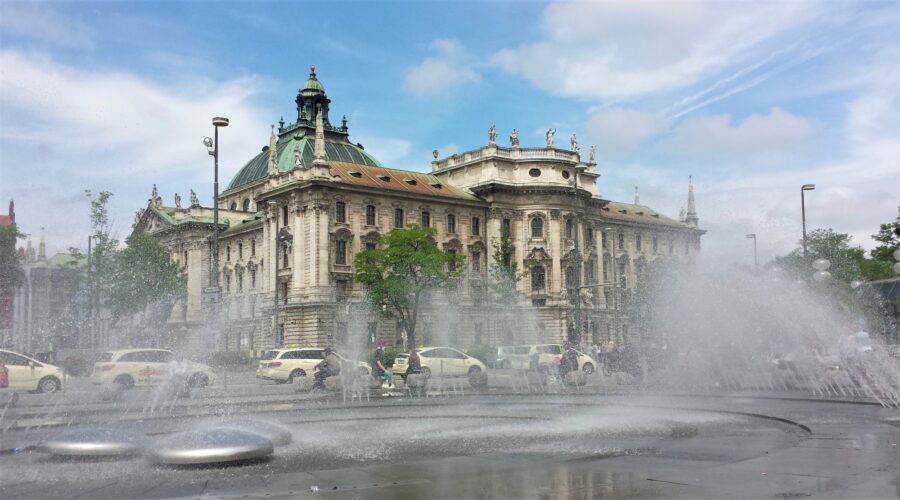
There are also endless shopping opportunities, including:
- Kaufhof: Built in 1950, this was the first department store in Munich.
- Stachus Passagen for some underground shopping.
- Shops, cafes, and restaurants lining the square.
- The entrance to Neuhauserstraße and Kaufingerstraße, the two main shopping streets of Munich.
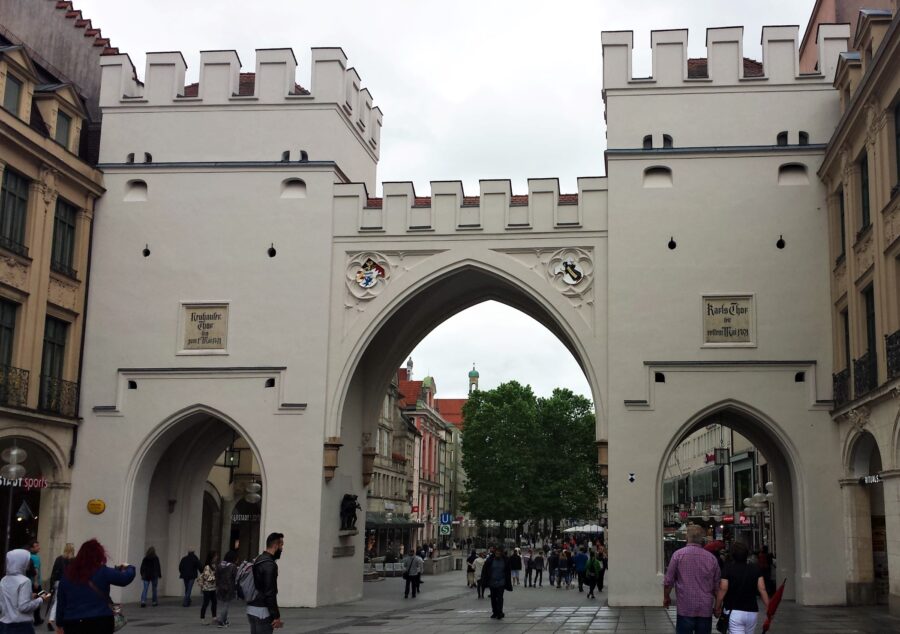
But before checking out the shops or continuing with our tour, take your time to soak up the atmosphere at Stachus. We will gradually head down Neuhauserstraße for the next stops on our free walking tour of Munich!
The Funny Story Behind the Dual Name of Karlsplatz-Stachus
The square was built in 1777 when the Elector Karl Theodor took over the government of Bavaria. Like any modest ruler, he named the new square after himself — Karlsplatz. But he was so unpopular with the residents that they refused to use that name. And so the square became known as Stachus, in memory of the tavern that was displaced for the square’s construction.
2) Bürgersaalkirche (Citizen’s Hall Church)
- Opening Hours: Upper church: Monday-Saturday, 11 am-1 pm.
Lower church: Monday-Saturday 10 am-5 pm, Sunday 2 pm-5 pm. - Cost: Free
- Walking Time from the Previous Stop: 4 minutes
- Website: https://www.mmkbuergersaal.de/
From Karlsplatz-Stachus, walk four minutes to our next stop: Bürgersaalkirche, otherwise known as the Citizen’s Hall Church.
From the outside, Bürgersaalkirche kinda looks more like a government building than a church. And, as a matter of fact, it was first built in 1709 as a “citizen’s hall” (hence the name), and was only consecrated in 1778. The church is also divided into an upper floor and a lower floor, with the exterior pink façade showing this division.
In the upper church, you’ll find the brightly lit, ballroom-like prayer room. Everywhere you look, there are works of art in the form of frescoes, paintings, and statues.
In the lower church, you can find the crypt of Ruper Mayer, a Jesuit priest known for his resistance against the Nazis. For a bit of history, I recommend walking around the small museum room containing memorabilia from his life.

If you’re planning to visit Germany but you’re still in school, click here to read my guide on how to travel as a student!
3) Michaelskirche (St. Michael’s Church)
- Opening Hours: The Crypt is open Monday to Friday from 9:30 am-4:30 pm, and the weekends from 9:30 am-2:30 pm.
- Cost: Free (or 2 euros to enter the Crypt).
- Walking Time from the Previous Stop: 2 minutes
- Website: https://www.st-michael-muenchen.de/en/
The next stop on our walking tour of Munich is St. Michael’s Church: an art gallery, an architectural masterpiece, and a place of worship all in one!
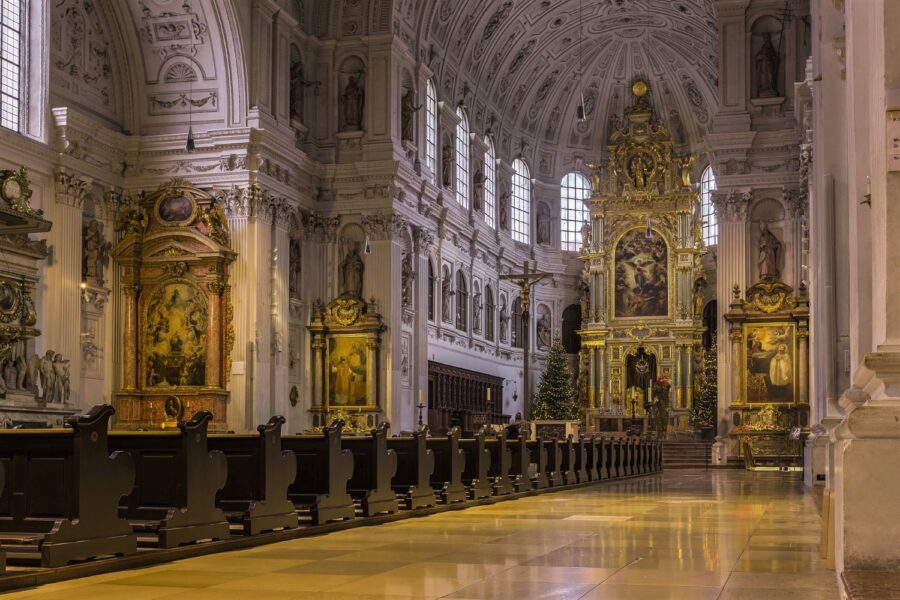
Built in the late 16th century, Michaelskirche was modeled after the Church of the Gesù in Rome. It’s best known for having the second largest vaulted roof (after St. Peter’s Basilica in Rome).
If you look between the two entrances, you’ll see St. Michael, the Archangel, slaying a dragon-like creature, which was meant to symbolize Catholicism triumphing over Protestantism in the Counter Reformation era.
And hey, if you’re craving a little company, why not visit the “Mad” King Ludwig II in the crypt?
4) Frauenkirche (Church of Our Lady)
- Opening Hours: Monday to Saturday 8 am-8 pm, Sunday 9:30 am-8 pm.
- Cost: Free
- Walking Time from the Previous Stop: 3 minutes
- Website: https://www.muenchner-dom.de/
Next, head over to Frauenkirche, one of the most popular landmarks in Munich.
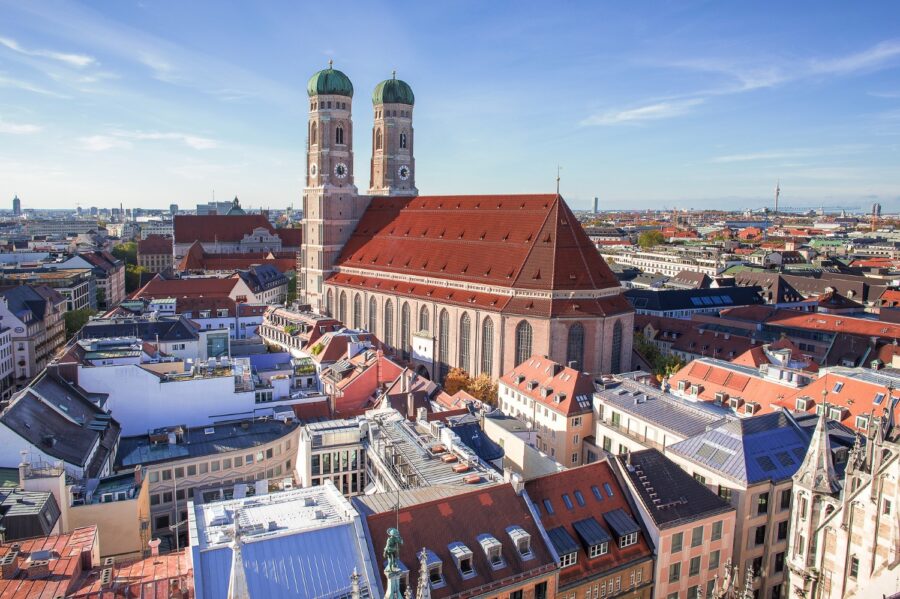
The original plan for Frauenkirche was a grand church of the likes of Stephansdom in Vienna. But budgetary constraints unraveled these plans into the plain red-brick construction that it is today.
In the end, this lack of funding is what shaped the church into the remarkable mix of styles that makes it so unique. By the time the towers were finally finished, the Renaissance era had started. Thus, domes were installed instead of the intended Gothic pointed towers.
These towers are an iconic part of the Munich skyline, jutting out far past any other building. The residents of Munich are deeply passionate about their city’s “mother church”; in 2004, they even voted to prohibit building anything taller than 98.57 meters — the height of Frauenkirche.
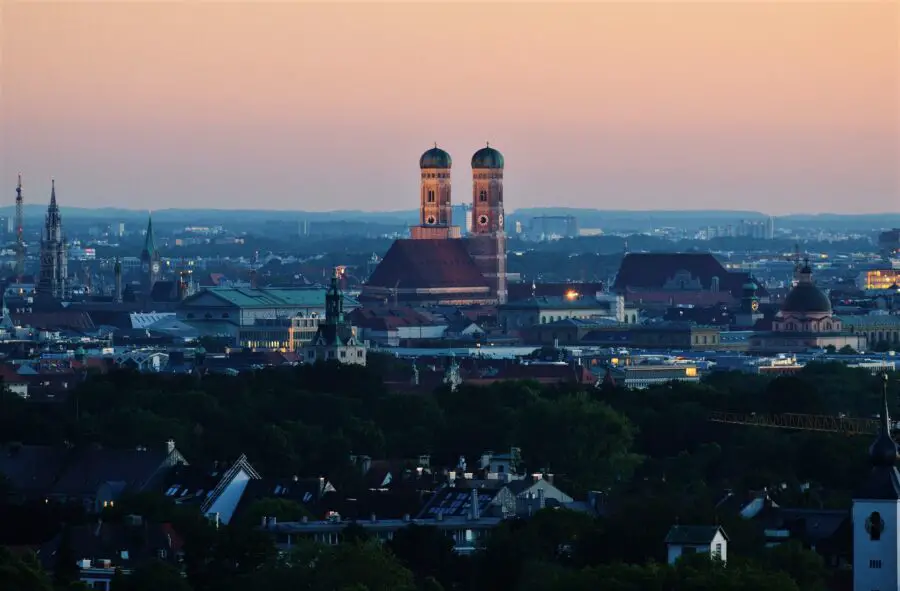
Inside, Frauenkirche has a remarkable capacity of 20,000 people. The decorations are simple, but there are still tons to admire, including:
- Gothic pillars
- Original stained-glass windows
- 14th-18th century artwork
- A 16th-century automaton clock
- The tomb of Holy Roman Emperor Louis IV
The Legend of the Devil’s Footprint
By the entrance, you’ll also notice a black mark resembling a footprint. Legend says the master builder Jörg von Halsbach struck a deal with the devil to ensure they had enough money for the church’s construction. In exchange, he promised to not build any windows, meaning the church could not be consecrated.
Stepping inside the completed church, the devil could not see the windows at first, as they were hidden from view by the columns and buttresses. But when he realized he’d been duped, he stomped his foot in anger and turned into the wind to try to blow the church down. If you stand outside the church, you can still feel the devil’s vain efforts!
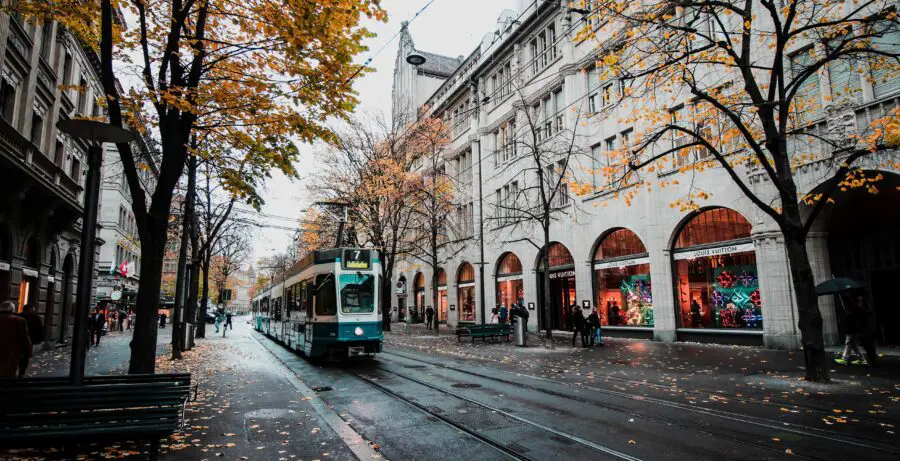
If you’re planning to travel Europe in the fall, click here for my Europe fall packing list for women!
5) Marienplatz
- Opening Hours: None
- Cost: Free
- Walking Time from the Previous Stop: 4 minutes
- Website: https://www.muenchen.de/int/en/sights/attractions/marienplatz.html
Next up on your Munich walking tour is Marienplatz, a plaza that will provide you with a short break from the stunning Munich churches and aerial city views!
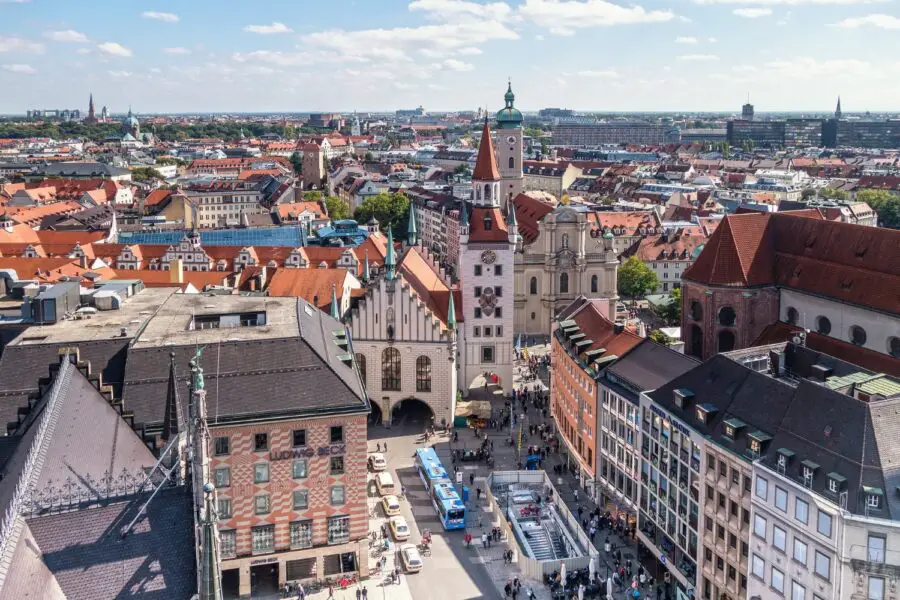
This popular square dates back to the city’s founding in 1158. It used to be a calm intersection where monks decided to settle, giving the city its name (“monks” in German).
The area soon became the city’s marketplace, then called “Schrannenplatz” (“grain plaza”). In 1854, the market outgrew the plaza and moved to Blumenstraße. The plaza was then renamed to Marienplatz after the Virgin Mary, for helping the city overcome a cholera epidemic.
The center of the plaza is marked by Mariensaule, the Virgin Mary column. It was erected in 1638 to celebrate the end of the Swedish occupation of Munich. Its base depicts the city’s triumph over famine (the dragon), war (the lion), the plague (the basilisk), and heresy (the snake).
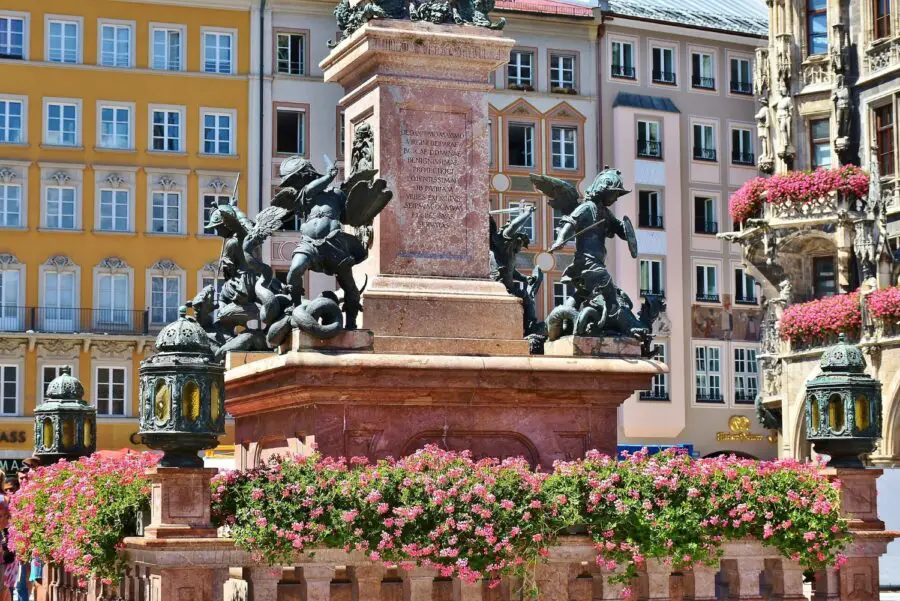
Events and Things to Do in Marienplatz
- June: Stadtgründungsfest, celebrating Munich’s birthday.
- December: a Christmas Market with 150 stalls.
- Year-round: Countless stores and restaurants — needless to say, it’s one of the best things to do in Munich on Sunday!
The Munich Marienplatz is where many of the free tours in Munich and walking tours in Munich start, so you’ll see lots of tourist groups here. The plaza itself has many interesting landmarks, which we are about to see!
6) Neues Rathaus (New Town Hall)
- Opening Hours: 10 am-7 pm Monday to Saturday, 10 am-5 pm on Sundays.
- Cost: 10 euros for tours, or 4 euros to access the tower.
- Walking Time from the Previous Stop: 0 minutes
- Website: https://www.muenchen.de/int/en/sights/attractions/new-town-hall-neues-rathaus.html
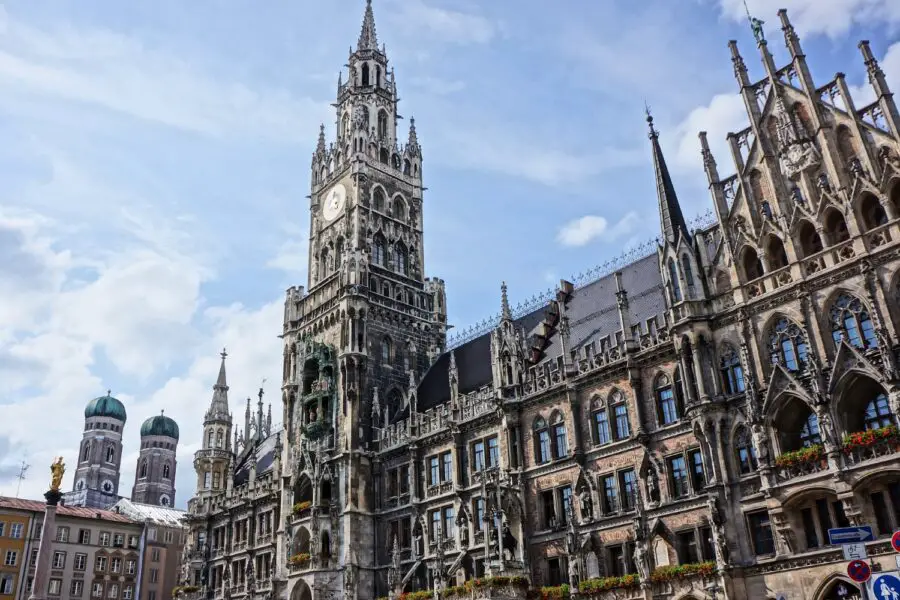
To reach the next stop on your free walking tour of Munich, just turn around and look for the Neues Rathaus right at Marienplatz! Although it’s only one building, it has plenty to offer, including some fun things to do with kids in Munich.
It was built in the late 19th century when the old town hall was no longer able to accommodate the government. And this new one sure takes care of the space issue — 12 buildings had to be demolished to make room for it! It also holds 400 rooms and takes up over 9000 square meters of space.
Surprisingly, Neues Rathaus Munich survived WWII, so the carvings you see are original. Don’t miss the “Glockenspiel,” a storytelling music box on the exterior of the tower. It is still manually operated and uses 43 bells and 32 life-sized figures to perform two historical events, including:
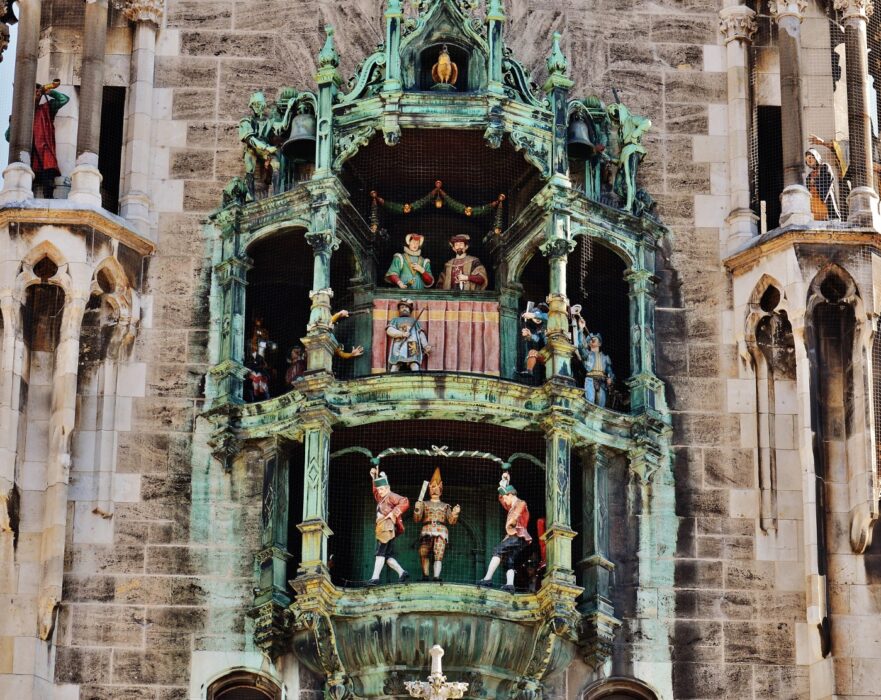
- A 1568 tournament celebrating the marriage of Duke Wilheim V to Renata of Lothringen.
- “Schäfflertanz”, or Coopers’ Dance: After the plague epidemic, the barrel makers were supposedly the first to go out into the streets, where they danced to give courage and joy to the fearful citizens.
The show lasts about 15 minutes. It’s performed daily at 11 am and 12 pm, so make sure you’re there for the show!
Before you turn away, look all the way up to the top of the tower and wave hello to “the Munich child”, aka “Münchner Kind.” This symbolic representation of Munich has had a prolific advertising career, as it’s been featured in Munich commercials for virtually everything under the sun.
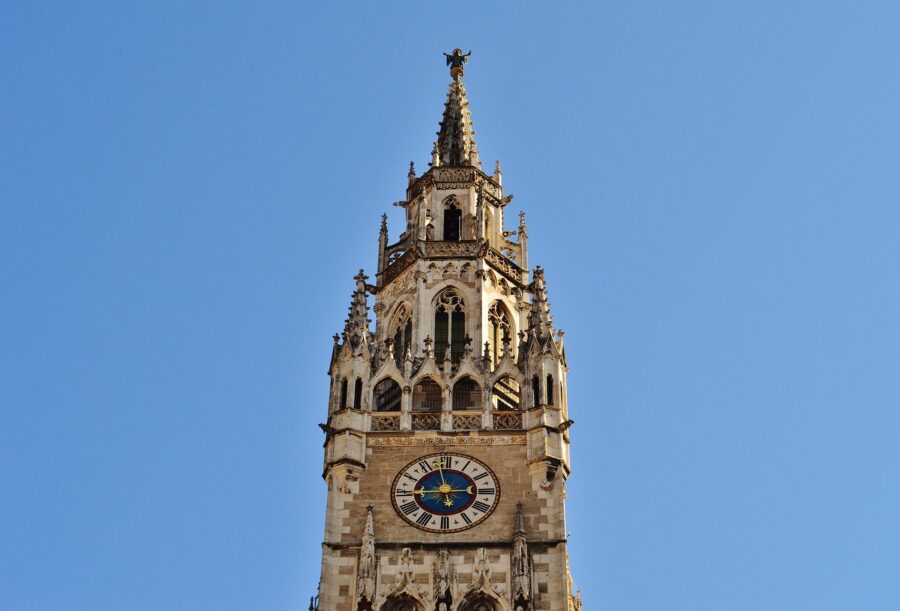
The New Town Hall also offers several other things to do, including
- A 90-minute tour.
- A tourist office on the ground floor.
- An 85-meter-tall tower with a great view of the old town of Munich.
- Marienhof, a small garden at the back.
- The Ratskeller restaurant in the basement.
7) Altes Rathaus (Old Town Hall)
- Opening Hours: 10 am-5:30 pm daily (for the Toy Museum).
- Cost: 6 euros for the Toy Museum.
- Walking Time from the Previous Stop: 1 minute
- Website: https://www.muenchen.de/int/en/sights/attractions/altes-rathaus.html
Now that we’ve admired the New Town Hall, it’s time to check out the Old Town Hall! Walk over to the eastern end of Marienplatz to find Altes Rathaus, Neues Rathaus’ predecessor.
The building goes back as far as 1310. But it has been damaged and rebuilt so many times that it has practically worn every architectural style since its founding. Its most recent restoration after WWII has brought it full circle to its original Gothic design. And with its plain façade, the Old Town Hall look more modern than the ornate New Town Hall Munich!
Altes Rathaus has a dark side as well. It was the location of the hate-filled speech by Joseph Goebbels that inspired Kristallnacht, “the night of the broken glass” in 1938. This is considered to be the start of the Holocaust.
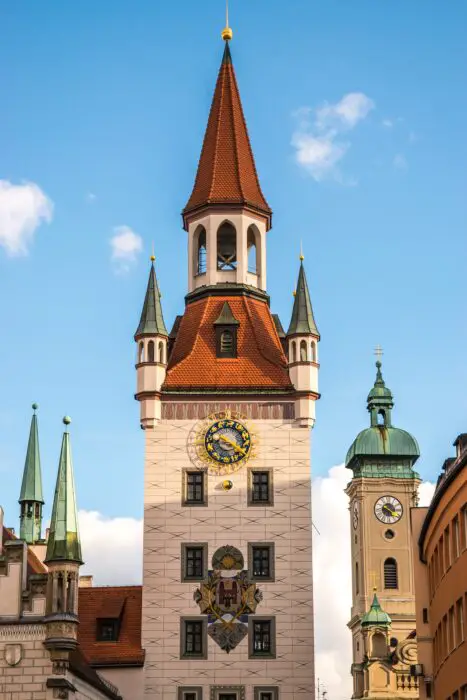
Other things you can see at Altes Rathaus:
- A historic toy museum located on over 4 floors of the tower (it’s one of the best things to do in Munich with kids!).
- A ballroom on the second floor with an impressive ornate wooden ceiling.
- A Juliet Capulet statue on the side of the building, gifted to Munich by Verona in the 1970s.
8) Peterskirche (St. Peter’s Church)
- Opening Hours: 9 am-6 pm Monday to Friday, 10 am-6 pm Saturday and Sunday.
- Cost: Free for the church, 3 euros for the tower.
- Walking Time from the Previous Stop: 2 minutes
- Website: https://www.muenchen.de/int/en/sights/churches/church-of-st-peter.html
Next on your Munich free walking tour is Peterskirche, the city’s oldest Catholic church dating back to the 12th century. Like many Munich landmarks, it has been reconstructed many times due to fires and wars. The inside reflects its many reincarnations with elements of the Gothic, Baroque, and Rococo styles.
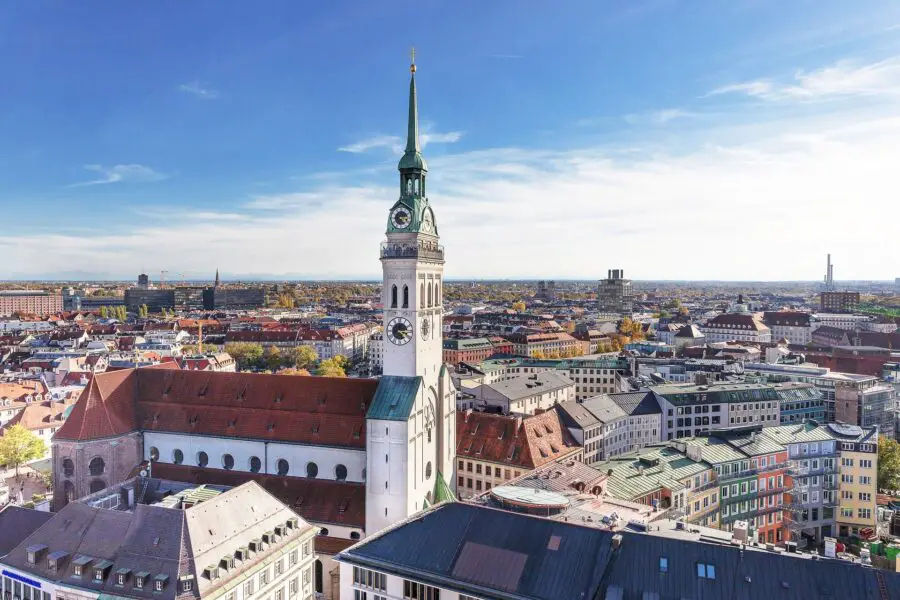
The most notable aspect of Peterskirche Munich is the second chapel, as it holds the skeleton of Saint Munditia, lavishly decorated with a crown, precious stones, and luxurious clothing. You’ll also see many beautiful works of art, though most of them are restorations.
And if you haven’t had enough bird-eye views of the city yet, you can climb the 300 stairs up the tower. On a clear day, you can see all the way to the Alps!
At the top, you’ll also find another peculiarity: no fewer than 8 clocks. The Munich-based comic Karl Valentin offered a whimsical reason as to why: “Well, of course, it’s so eight people can check the time at once!”
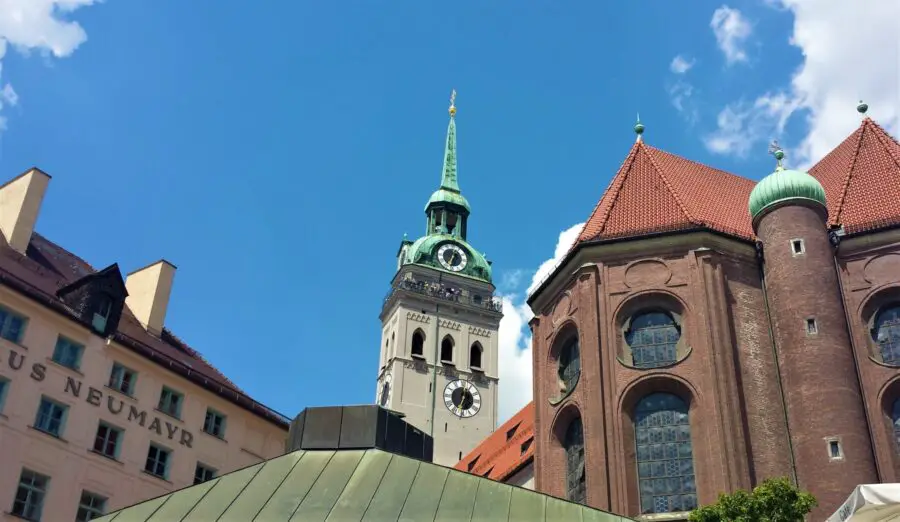
9) Asamkirche (Asam Church)
- Opening Hours: 9 am-6 pm
- Cost: Free
- Walking Time from the Previous Stop: 6 minutes
- Website: https://www.muenchen.de/int/en/sights/churches/asam-church.html
Compared to the gargantuan buildings you’ve seen so far, the 22-by-8-meter Asamkirche in München might seem ludicrously tiny. But what it lacks in size, it more than makes up for in decoration.
Through the opulent wooden door, you enter a space filled with such an excessive amount of stucco and ornamentation, it’s downright overwhelming. There’s barely an inch left undecorated.
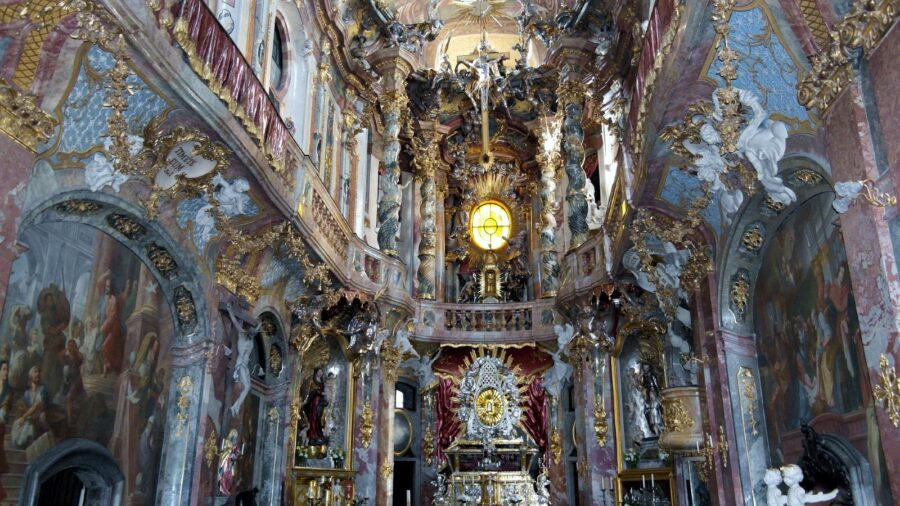
The church is divided into three vertical levels:
- The rather gloomy lower area, where visitors sit, symbolizes worldly suffering.
- The middle level, reserved for the Emperor, is decorated in white and blue.
- The top, dedicated to God, is brightly lit.
Naturally, the space gets brighter the closer to heaven it goes. The ceiling also has a lavish fresco portraying the drowning of Saint Nepomuk, to whom the church is dedicated.
10) Viktualienmarkt (Victuals Market)
- Opening Hours: Usually 8 am-8 pm Monday to Saturday, but it depends on the stall.
- Cost: Depends on what you buy.
- Walking Time from the Previous Stop: 7 minutes
- Website: https://www.viktualienmarkt-muenchen.de/
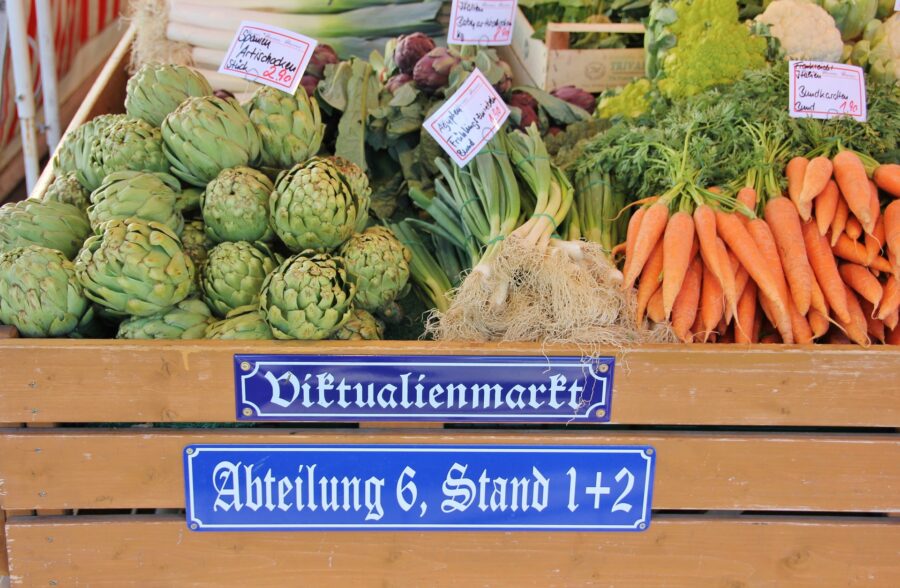
Remember how Marienplatz used to be a marketplace? Well, Viktualienplatz is where it moved.
Viktualienmarkt, from the late Latin word for food, stretches over 22,000 square meters. About 150 stalls offer everything your fridge and pantry could desire, from vegetables to fish, through spices and pastries, and even kitchen accessories and other trinkets. Every Munich food guide will recommend visiting this famous market!
Halls and pavilions were added as even Viktualienmarkt Munich started lacking in space for its eager shoppers. At the center, you’ll find an authentic Bavarian Maypole displaying aspects of life in Munich.
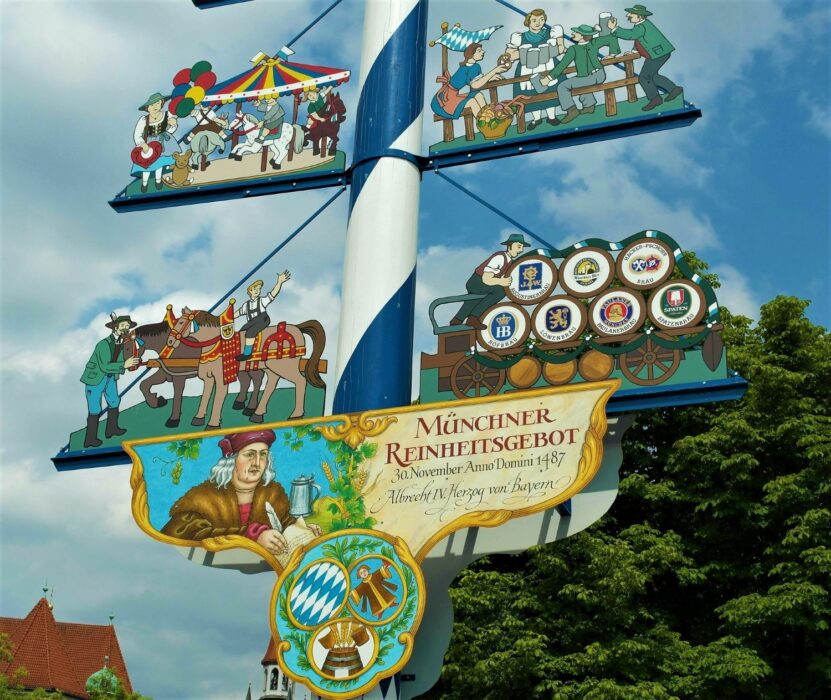
If you need to rest your feet a little, you can relax in the beer garden. Then walk around to find the fountains with statues commemorating folk singers and comedians.
11) Hofbräuhaus München
- Opening Hours: 9 am-12 am daily.
- Cost: Depends on what you order.
- Walking Time from the Previous Stop: 6 minutes
- Website: https://www.hofbraeuhaus.de/en/hofbraeuhaus.html
Today, we associate Germany with tall glasses of beer, but 500 years ago, Bavaria was far from being a beer nation. At the time, beer was imported from Northern Germany, and boy, was it expensive! Like any beer lover, the rulers wanted more beer for less money, and commissioned their own brewery in 1589: the Hofbräuhaus München
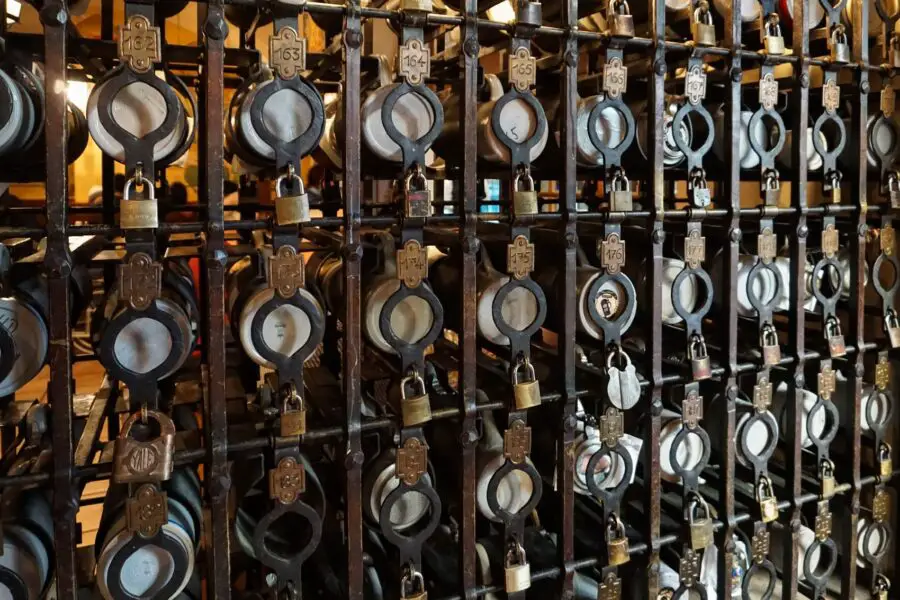
It was initially reserved for royals, and they were only allowed to brew stout and white beer. The beer hall was then added in 1897 and eventually opened to the public.
You can take a look at the glass cellar or sit down for a refreshing drink — perhaps in the very same spot where Mozart or the Empress Elisabeth of Austria once sat! Adolf Hitler presented his “25-Point Program” in this very bar as well.
You can unwind here until as late as midnight — the Hofbräuhaus is hands down one of the best things to do in Munich at night!
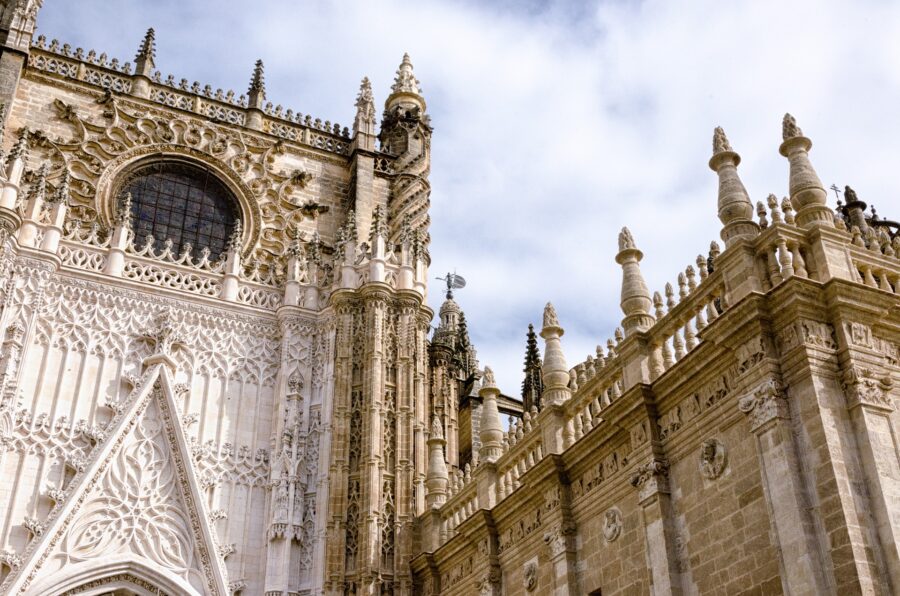
If you’re also thinking of visiting Seville, Spain, click here to read my self-guided walking tour of Seville!
Got More Time to Explore Munich?
If you have time leftover after your Munich walking tour, consider adding these things to do in Munich, located close to where your tour left off:
- National Theater
- Theatine Church
- Munich Residenz
And obviously, if you’re visiting Munich in mid-September to October, you have to check out Oktoberfest! The largest beer festival in the world, Oktoberfest is a 17- to 18-day festival where you can drink tons of beer, enjoy some rides and carnival games, and wear Trachten, the traditional outfits for Oktoberfest.
Finally, if you’re wondering what else to do in Munich, here are the top attractions not yet mentioned:
- English Garden
- Nymphenburg Palace
- Alte Pinakothek
- BMW Museum
- Neuschwanstein Castle (one of the best day trips from Munich!)
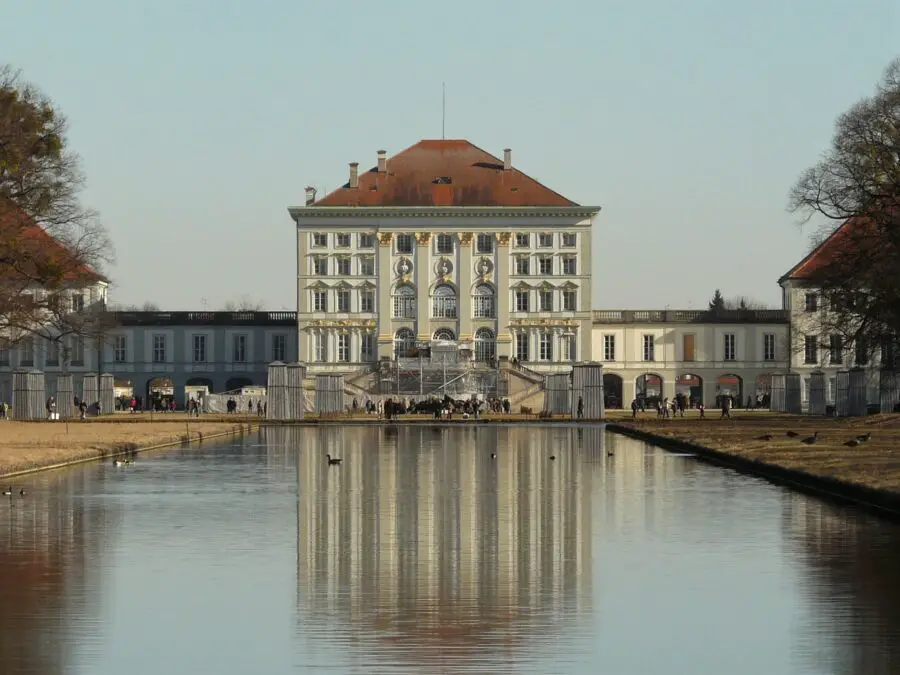
And That’s It for our Free Walking Tour of Munich!
And so we have come to the end of your free walking tour of Munich. If you have 2 days in Munich or even just 1 day in Munich, this walking tour will help you make the very best of your time. Happy exploring!
Thanks for reading the article! If you have any questions, feel free to comment down below, and if you want to see more travel and hike-related content, make sure to check out my other articles.
Cheers,

Photos by Mia and Pixabay.
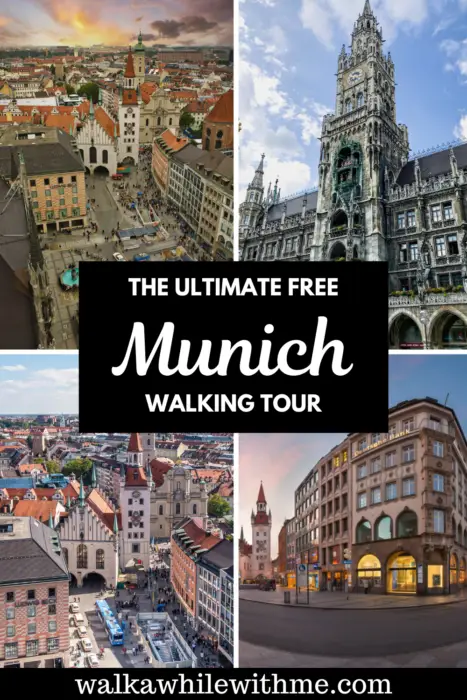
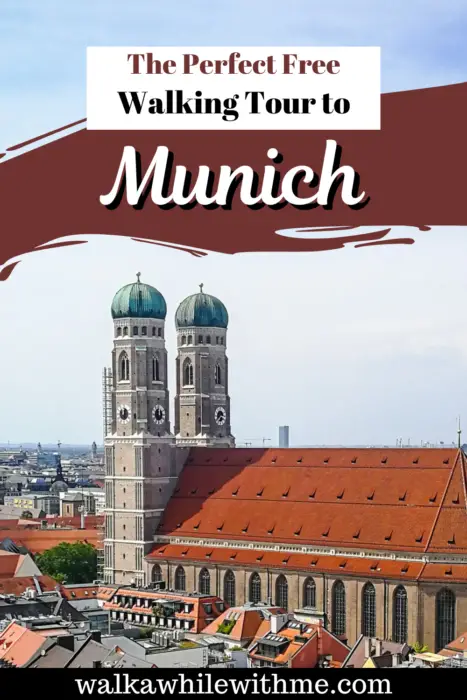
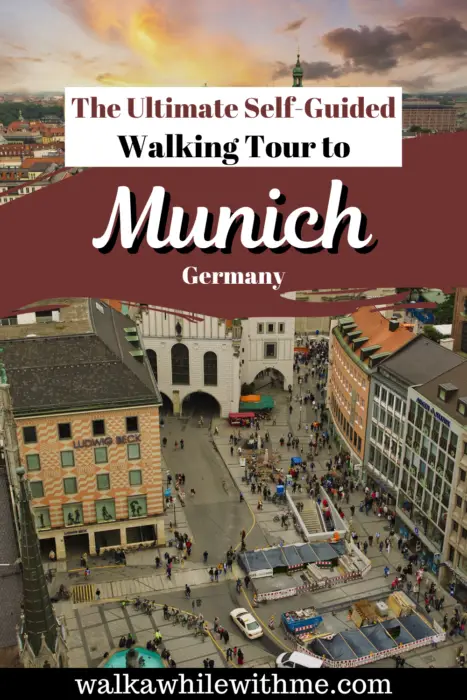
About to embark on a trip around Europe? Here are some helpful articles to make your trip as awesome and stress-free as possible:
- How to Travel Around Europe
- How to Travel Without Breaking the Bank
- 15 Things to Do Before a Trip
- My 5-Week Europe Itinerary
- The Minimalist Europe Fall Packing List for Women
- How to Start Hiking: 15 Beginner Hiking Tips
And here are some additional helpful links:
- Click here for my walking tours
- Click here for my hiking guides
- Click here for more posts on Europe
- Click here for more posts on Germany
- Click here for more resources
Like this post? Share it!
